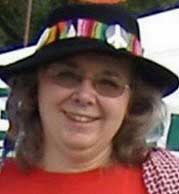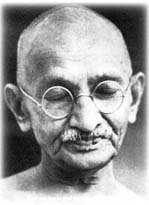
Non-Violence & Decentralization
by Carol Moore
Revised. Original published in 1985 in The Peacemaker, Peace Conversion Times, & the Green Letter.
Carol Moore is a longtime student of consciousness and libertarian decentralist pacifist activist, writer, songwriter and video producer. She has been active over the years in the radical feminist, anti-nuclear, peace, libertarian, Green/bioregional, radical decentralist, drug legalization and new age consciousness movements.
Mahatma Gandhi often said that non-violence and freedom are inextricably intertwined. In the first half of the twentieth century he wrote: “The attainment of freedom, whether for a man, a nation or the world, must be in actual proportion to the attainment of non-violence by each.” And he held that: “No action which is not voluntary can be called moral....Any action that is dictated by fear or by coercion of any kind ceases to be moral....Freedom of the individual is at the root of all progress.” Gandhi believed in these principles so much that he advocated that whatever laws were decided upon should be enforced only by non-violent police and that armies should be organized by non-violent methods.
As I will discuss below, more and more non-violent theorists and activists are exploring the full implications of organizing society by principles of non-violence And many of these theorists are coming to the inalterable conclusion that Gandhi was right–freedom and non-violence are two sides of the same coin. Moreover, they are recognizing that without the threat of brute military and police violence, most great nation states would break up into much smaller political entities; that without violent coercion decision-making would be dispersed widely among individuals, groups and self-governing communities and cities; that organizing society by principles of non-violence would decentralize power throughout society.
Superiority of Non-Violent Action
Gandhi, Martin Luther King, numerous activists and non-violent scholars like Gene Sharp (author of “The Politics of Non-Violent Action” and “National Security through Civilian-based Defense”) and Barbara Bondurant (“The Conquest of Violence”) have argued and illustrated the superiority of non-violent to violent action.
The purpose of non-violent action is to withdraw consent from government or other authorities, rather than wrest power from them. Therefore it fosters dialogue and education and allows maximum participation by everyone in society. Non-violence heightens the moral superiority of the actionists in the eyes of the general public--especially if the authorities respond to their sincere and open protest with violence. Even members of the ruling classes can be swayed to sympathy by such non-violent actions. Police and soldiers wooed with sound political arguments and non-violent demonstrations are more likely to come over to the side of the activists than ones afraid of being shot and killed by protesters.
Political violence harms groups and movements. It destroys public sympathy, reinforces public prejudices against activists, invites police infiltration and harassment, and gives the state an excuse to arrest, imprison and even kill innocent activists and bystanders. Even advocacy of violence can have a detrimental effect on organizing since it divides and demoralizes activists and provides the government and media an excuse to attack the advocates.
Violent action usually is practiced predominantly by angry young men, often with military training, who often become as ruthless towards other dissidents as they do towards the oppressor. These days the most vocal advocates of violence are often government provocateurs. When violent revolutionaries take power, their regimes usually are as ruthless as their revolutions.
Non-violent non-cooperation by large numbers of people is more disruptive to the state than violence by smaller numbers; violence only permits the state to enhance its power. Overall, non-violent action results in the least loss of life and property, the least destruction of the social fabric and the greatest assurance that post-resistance society will be free and peaceful.
In the last twenty years relatively non-violent mass movement--“people power”-- overthrew the Shah in Iran, Marcos in the Philippines, apartheid in South Africa, Suharto in Indonesia, and brought about freedom for Eastern Europe and the dissolution of the Soviet Union. Most of these activists were at least aware of the success of the efforts of Gandhi and Martin Luther King. Some leaders of these movements studied or were trained in non-violence . Today, organizations like Non-violence International, International War Resisters League and Peacekeepers International are continuing to spread these ideas and strategies worldwide.
Non-Violent Civilian-Based Defense

Gandhi
Influenced by the writings and efforts of Gene Sharp and organizations like the Civilian-Based Defense Association, and impressed by the successes of non-violent action in recent revolutions, even the Swedish, German and French governments have studied the concept of non-violent civilian based defense. This is a broadening and updating of Gandhi’s notion of “non-violent armies.” National militaries would be supplemented and even largely replaced by training all citizens in organizing economic, political and social non-cooperation. The object would be to destroy an invader's ability to control the populace and to undermine its troops’ morale. In 1968, unorganized Czechs managed to do this to their Russian invaders for a number of months, bolstering non-violent actionists' hopes that an organized and determined populace would deter any invasion.
Non-Violent Conflict Resolution
In the last twenty years non-violent activists in a variety of movements have begun to focus on non-violent conflict resolution not only between nations but on the interpersonal level between individuals, between warring gangs in the inner cities, between religious, racial, ethnic and lifestyle groups, and even within their own groups. (As one activist said, “A pacifist is a person who can go to a peace meeting and not get in a fight.”)
Conflict between individuals, groups and communities is inevitable--but bad will, bad mouthing, sabotage, destruction of property and violence are not. Gandhi contended that there is some truth in both or all sides of a conflict and that only through non-violence can we appreciate and tolerate differing views of truth--or come to an understanding of a greater truth. Opponents must be recognized as potential allies, and all sides must search for resolutions that are mutually satisfying, “win-win”ones. Of course, various forms of protest may be necessary to impress the “opponent” with the seriousness and sincerity of one's claims or to convince them to enter into negotiations. But negotiations are the goal.
Non-Violent Sanctions
Many non-violent actionists have gone to the next step. They have come to regard all political conflict over laws, regulations and taxes as conflicts to be resolved non-violently, not as issues to be settled by the vote of the majority (usually the defacto will of special interests) and enforced by the threat of police violence, confiscation of property and imprisonment.
Non-violent activist groups have long used consensus-oriented decision-making in their groups to ensure the maximum of support for policies, strategies and actions. Many of their members have come to realize that the same principle must be applied to politics–only laws, regulations and taxes supported by the overwhelming majority of people should be imposed. Only those basic community services supported by overwhelming majorities would be provided, since the collection of taxes for them would no longer be enforced through the threat of police violence. Non-violent resistance to such laws, rules or taxes would be a respected component of ongoing community debate.
Police violence, like individual violence, would be reserved only for defense of self or others from physical violence. Public courts and police would still deal with such universally deplored acts as murder, assault, pollution, theft and fraud. However, police would be, as Gandhi said, “a body of reformers...composed of believers in non-violence . They will be servants, not masters.” To deal with minor offenses, police would use education, verbal persuasion and publicly. If that was ineffective, they might organize citizen picketing or boycott. More serious crimes might result in ostracizing or expelling the individual from the community. (This is one variation on the polycentric law idea I detail at length in Non-Violent Secessionist Strategies.)
Non-violent sanctions are based on trust that humans who share the consciousness that violence is illegitimate (except in extreme circumstances of self-defense) and are taught from childhood the many subtle and creative ways of attaining their goals without using violence, will rarely resort to it. To connect two popular sayings, if “violence begets violence” then “the only way to peace, is peace itself!” Otherwise we become willing co-creators of our violence-wracked system. As Gandhi said, “Every citizen silently, but never the less certainly, sustains the government of the day in ways of which he has no knowledge. Every citizen, therefore, renders himself responsible for every act of his government.”
Non-Violence and Decentralization
It is easily arguable why “complete non-violence ” would lead to political and economic decentralization. Most centralized governments and nation sates were formed from a number of formerly autonomous communities, cities and regions through armed conquest. Some were formed hundreds of years ago--others only in the last few decades. Their different ethnic, racial, religious and national groups are held together by nationalist jingoism, government subsidies, and the threat of terrible military vengeance against secessionists.
Nevertheless, secessionist sentiments, activities and demands to be completely free of centralized control have escalated worldwide. When I first wrote this piece in 1985 I wrote ”Eastern European and Asian people seek to free themselves from Soviet control.” They did so in 1989, and non-violently. In fact, it was non-violent change in Czechoslovakia (which itself later peacefully divided into two nations) that became known as the “Velvet Revolution.”
However, Yugoslavia's power-mad leader replied to Croatia and Bosnia’s attempts to secede from Yugoslavia with ethnic hatred and “ethnic cleansing” by the militarily superior Serbs. Nigeria, Somalia, Sudan, Ethiopia, Rwanda and other African nations remain rife with racial, religious and tribal violence between communities forced into artificial “nation states,” first by colonists and later by repressive dictators. Many of Indonesia’s thousands of Islands could decide to go their separate way. India, which contains hundreds of religious, linguistic and ethnic groups, continually suppresses its separatist factions. Closer to home, should Quebec finally vote to secede, it is likely British Columbia might do so as well, breaking up a nation right at our borders. And it is clear that demographic, social and economic factors already are dividing America. Only the smallest and most culturally and politically homogenous nations could be held together if they had to rely on non-violent sanctions and non-violent armies or civilian-based defense.
Once free of the fear of violence from centralized authorities, decentralization would probably proceed quite rapidly as counties seceded from states, cities from counties and even neighborhoods from cities. The concept of “neighborhood power” would become a reality. Innumerable experiments with non-violent governance would be tried and those which proved most successful would become most popular. Networking and confederations between neighborhoods, communities, cities and regions would be necessary to deal with common problems and resolve conflicts. But without massive military violence, there could be no return to the centralization of the past.
There is no doubt that we will live in times of mounting economic, political and military crisis, which will further undermine the credibility of established institutions and open more people to radical change. And we may yet experience a devastating nuclear exchange that will destroy the great nuclear powers. If pacifists and decentralists are not ready with new visions equal to the crisis and disasters we face, we can be sure that demagogues of all stripes will be. It is a matter of human responsibility that we re-think our politics and create thorough and credible non-violent alternatives–in full light of their decentralist implications.
The Courage to Choose Non-Violence
Those of us who believe that humans should conduct our affairs non-violently should not be afraid of the radically decentralist implications of our beliefs. Rather we should explore them and even emphasize them, as do Gandhians, anarchist pacifists, libertarians, and many Greens, eco-feminists and bioregionalists. They oppose the structural violence of large nation states.
Many who say they are committed to non-violence and non-violent conflict resolution merely use non-violent action to strengthen state power–and the state’s excuses for, and ability to use, violence against citizens. This includes activists in the feminist, environmentalist, labor, anti-racism and bigotry, anti-corporate, and social welfare movements. Perhaps the epitome of this hypocrisy is the gun control movement which calls for heavily armed federal agents to assault, arrest and imprison Americans who refuse to give up the ever-growing list of proscribed weapons. In fact, it is the fear of such a vicious and powerful state that is causing freedom-lovers to arm themselves so heavily.
Meanwhile too many pro-freedom activists who challenge the growing state power and violence believe the old saw that there are only two political alternatives, the ballot or the bullet. (A statement with which leftist who advocate violence also agree.) Freedom lovers must take the step their “liberal opponents” have taken: learn the effectiveness of non-violent action and conflict resolution in social, economic, and political protest and resistance.
Members of groups left and right must learn more about non-violent conflict resolution between individuals, groups and nations, about non-violent civilian-based defense against political repression and foreign invasion, and about non-violent sanctions as the alternative to violent sanctions in enforcing rules and laws. And having learned about those they may finally come to the conclusion that Gandhi did--that only the voluntary society is moral and that the essence of human enlightenment is organizing our affairs in a voluntary manner without the ever present threat of state violence. As Gandhi said, the only way to peace is peace itself.
Copyright 1998 by Carol Moore. Permission to reprint freely granted, provided the article is reprinted in full and that any reprint is accompanied by this copyright statement and the URL http://www.carolmoore.net.
